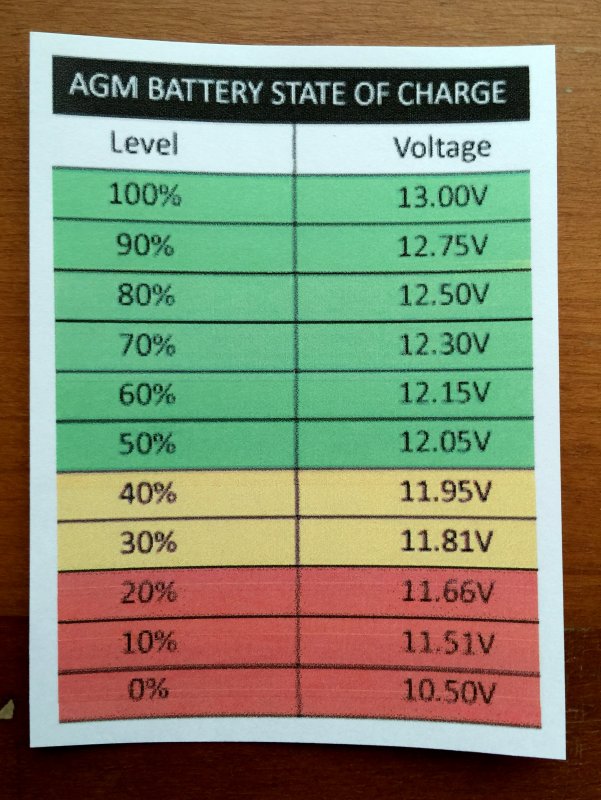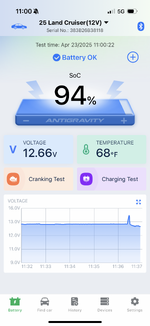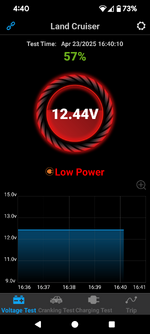Navigation
Install the app
How to install the app on iOS
Follow along with the video below to see how to install our site as a web app on your home screen.
Note: This feature may not be available in some browsers.
More options
You are using an out of date browser. It may not display this or other websites correctly.
You should upgrade or use an alternative browser.
You should upgrade or use an alternative browser.
Deep cycle agm battery replacement?
- Thread starter phantasticphil
- Start date
I'm aware of that, do you have to time or desire to fight that out in court? I don't. But, the Antigravity does look like a fantastic option for the LC w/ the issue some members are having. I'll probably end up putting on in if I ever have the issues some members are having, but that is an expensive battery lol.I would think the Magnuson-Moss Warranty Act would prevent Toyota from blaming the battery. MMWA is the reason we can safely choose to use after market parts on our cars, but still expect the warranty to be honored. A manufacturer can't just point to an after market part and refuse to cover the warranty.
I did some additional reading on the AntiGravity last night. What I found was some people were having issues with the BMS (battery management system). If the BMS fails, then the battery is junk even though the cells are still good. The warranty isn't great - 3 years with a maximum of 1 replaced battery. In addition, it sounds like you are responsible for paying to ship the battery to AntiGravity to obtain warranty replacement. If it fails again within the warranty period, you have a brick. The BMS may cause voltage spikes which could potentially damage the ECU or other electronic components. Some people also complained that getting warranty service through AntiGravity was difficult with AntiGravity denying warranty claims. Of course, I take everything with a grain of salt, this being the internet. You could get the AntiGravity and experience no issues. Or, you could get it, the BMS could destroy your ECU, and you would need both a new battery and a new ECU which Toyota may not replace under warranty. AGM batteries have some advantages over flooded lead-acid batteries, notably their resistance to vibrations, that might make an AGM a better choice than a traditional lead-acid battery.I'm aware of that, do you have to time or desire to fight that out in court? I don't. But, the Antigravity does look like a fantastic option for the LC w/ the issue some members are having. I'll probably end up putting on in if I ever have the issues some members are having, but that is an expensive battery lol.
Following up...here's some links to some reviews of AntiGravity batteries.
Review #1
Review #2
Review #3
Review #4
Review #5 (positive review)
Review #6 (tl;dr, the most comprehensive review)
You can certainly find positive reviews in addition to the negative ones. People tend to post more often when they run into issues.
I'm also wondering if another manufacturer of LiPO4 or LiFePO4 car batteries might be cheaper and more reliable. Hard to tell based on my research so far.
Review #1
Review #2
Review #3
Review #4
Review #5 (positive review)
Review #6 (tl;dr, the most comprehensive review)
You can certainly find positive reviews in addition to the negative ones. People tend to post more often when they run into issues.
I'm also wondering if another manufacturer of LiPO4 or LiFePO4 car batteries might be cheaper and more reliable. Hard to tell based on my research so far.
Last edited:
Sorry that this is slightly off topic... I am intensely interested in my battery charge, as I do a ton of remote back-country camping, and am very concerned about running into a dead battery. (Incidentally, I carry a PAIR of NOCO jump starters, just in case!!)For full transparency I have been using/selling their batteries since 2014.
I have their lithium batteries in my Subaru BRZ’s, my Motorcycles and two in my FJ Cruiser a 60ah group 27r for starting with a RedArc BCDC charging a 120ah deepcycle house battery.
I used their battery tracker to watch and log the charging profile of my 2025 LandCruiser.
My question is this... I've used for many years an external battery tester, that with previous cars, I've always just connected directly to the battery to get a reading on the tester (volts, SOC, battery health, etc.). But for unknown reasons, with my '25 LC, if I just connect the tester to the battery (or the engine jump terminals), I get incorrect readings... For instance, after fully charging the battery with an external charger, my tester will show that the battery health is BAD, and the voltage is lower than I'd expect, around 12.6 volts). BUT -- if I disconnect the battery neg terminal from the car first and then test the battery, everything looks good (12.8 volts, 100% SOC, battery health 100%, etc.) And if I reconnect the negative to the battery and retest, I get erroneous results again.
I have now installed a battery monitor (directly to the battery), so that I can see the test results on my phone (connected via bluetooth). I get similar results to those of my external battery tester -- that is, although the volts appear to be correct, the SOC and health numbers appear to be off (i.e. health is bad, even tho I just recharged the battery).
Your battery monitor does not seem to have the same problems that my tester and monitor have. What exactly are you using, and where have you connected it to? THANK YOU for your help!
The reason the voltage increases when you disconnect the battery is because the battery has internal resistance. If the battery is connected to the car, some current will be flowing, so the internal resistance of the battery causes a decrease in the voltage between the terminals. When you disconnect the battery, the internal resistance makes no difference because no current is flowing. As a result, the voltage between the terminals will be higher.Sorry that this is slightly off topic... I am intensely interested in my battery charge, as I do a ton of remote back-country camping, and am very concerned about running into a dead battery. (Incidentally, I carry a PAIR of NOCO jump starters, just in case!!)
My question is this... I've used for many years an external battery tester, that with previous cars, I've always just connected directly to the battery to get a reading on the tester (volts, SOC, battery health, etc.). But for unknown reasons, with my '25 LC, if I just connect the tester to the battery (or the engine jump terminals), I get incorrect readings... For instance, after fully charging the battery with an external charger, my tester will show that the battery health is BAD, and the voltage is lower than I'd expect, around 12.6 volts). BUT -- if I disconnect the battery neg terminal from the car first and then test the battery, everything looks good (12.8 volts, 100% SOC, battery health 100%, etc.) And if I reconnect the negative to the battery and retest, I get erroneous results again.
I have now installed a battery monitor (directly to the battery), so that I can see the test results on my phone (connected via bluetooth). I get similar results to those of my external battery tester -- that is, although the volts appear to be correct, the SOC and health numbers appear to be off (i.e. health is bad, even tho I just recharged the battery).
Your battery monitor does not seem to have the same problems that my tester and monitor have. What exactly are you using, and where have you connected it to? THANK YOU for your help!
OK, thanks! BUT -- the bigger issue that I encounter with an external tester (and also with my battery monitor) is that the SOC and battery health values seem to be way off, if the battery is connected to the car while doing the test. This leads me to trying to assess my battery SOC based only on the voltage, which is iffy... (There are lots of different tables on the net showing significantly different SOCs for various voltage levels, so there appears not to be a single "correct" answer...)
For example -- after I fully charged the battery to completion (with an external NOCO charger), my tester showed a battery health of only 7%... and when I disconnected the negative terminal to the battery and retested, it showed 100% health (which is what I would have expected with a fully charged new battery). And when I reconnected the battery and then retested, the health and SOC values were way off again (in this case, SOC was 78%, and health was 62%).
I see something similar with my battery monitor (which is connected directly to my battery)... After fully recharging the battery, then giving it a couple hours to "rest", my battery monitor reported 12.88 volts and 91% SOC. Fully charged, and showing 12.88 volts, I'd of expected 100% SOC. And the next morning, it was down to 12.77 volts and 81% SOC. I believe the volts, but not the SOC...
I never had issues testing a connected battery with my previous two (non-hybrid) cars, and the instructions for my TOPDON BT-100 do not require (or even suggest) that I disconnect the battery before testing. There is something different about the LC hybrid system, vis-a-vis testing it seems... What prompted me to ask about this was that the battery monitor screen shots from the original poster showed presumably accurate (at least believable!) results for SOC...
For example -- after I fully charged the battery to completion (with an external NOCO charger), my tester showed a battery health of only 7%... and when I disconnected the negative terminal to the battery and retested, it showed 100% health (which is what I would have expected with a fully charged new battery). And when I reconnected the battery and then retested, the health and SOC values were way off again (in this case, SOC was 78%, and health was 62%).
I see something similar with my battery monitor (which is connected directly to my battery)... After fully recharging the battery, then giving it a couple hours to "rest", my battery monitor reported 12.88 volts and 91% SOC. Fully charged, and showing 12.88 volts, I'd of expected 100% SOC. And the next morning, it was down to 12.77 volts and 81% SOC. I believe the volts, but not the SOC...
I never had issues testing a connected battery with my previous two (non-hybrid) cars, and the instructions for my TOPDON BT-100 do not require (or even suggest) that I disconnect the battery before testing. There is something different about the LC hybrid system, vis-a-vis testing it seems... What prompted me to ask about this was that the battery monitor screen shots from the original poster showed presumably accurate (at least believable!) results for SOC...
Yes, that's an entirely different question. I agree with you that it seems likely that the integration of the battery into the hybrid system appears to be affecting your ability to use your tester to check the state of charge of the 12 V battery.OK, thanks! BUT -- the bigger issue that I encounter with an external tester (and also with my battery monitor) is that the SOC and battery health values seem to be way off, if the battery is connected to the car while doing the test. This leads me to trying to assess my battery SOC based only on the voltage, which is iffy... (There are lots of different tables on the net showing significantly different SOCs for various voltage levels, so there appears not to be a single "correct" answer...)
For example -- after I fully charged the battery to completion (with an external NOCO charger), my tester showed a battery health of only 7%... and when I disconnected the negative terminal to the battery and retested, it showed 100% health (which is what I would have expected with a fully charged new battery). And when I reconnected the battery and then retested, the health and SOC values were way off again (in this case, SOC was 78%, and health was 62%).
I see something similar with my battery monitor (which is connected directly to my battery)... After fully recharging the battery, then giving it a couple hours to "rest", my battery monitor reported 12.88 volts and 91% SOC. Fully charged, and showing 12.88 volts, I'd of expected 100% SOC. And the next morning, it was down to 12.77 volts and 81% SOC. I believe the volts, but not the SOC...
I never had issues testing a connected battery with my previous two (non-hybrid) cars, and the instructions for my TOPDON BT-100 do not require (or even suggest) that I disconnect the battery before testing. There is something different about the LC hybrid system, vis-a-vis testing it seems... What prompted me to ask about this was that the battery monitor screen shots from the original poster showed presumably accurate (at least believable!) results for SOC...
This is the one I use. It is their gen2 of them that does agm/leadacid and lithiumSorry that this is slightly off topic... I am intensely interested in my battery charge, as I do a ton of remote back-country camping, and am very concerned about running into a dead battery. (Incidentally, I carry a PAIR of NOCO jump starters, just in case!!)
My question is this... I've used for many years an external battery tester, that with previous cars, I've always just connected directly to the battery to get a reading on the tester (volts, SOC, battery health, etc.). But for unknown reasons, with my '25 LC, if I just connect the tester to the battery (or the engine jump terminals), I get incorrect readings... For instance, after fully charging the battery with an external charger, my tester will show that the battery health is BAD, and the voltage is lower than I'd expect, around 12.6 volts). BUT -- if I disconnect the battery neg terminal from the car first and then test the battery, everything looks good (12.8 volts, 100% SOC, battery health 100%, etc.) And if I reconnect the negative to the battery and retest, I get erroneous results again.
I have now installed a battery monitor (directly to the battery), so that I can see the test results on my phone (connected via bluetooth). I get similar results to those of my external battery tester -- that is, although the volts appear to be correct, the SOC and health numbers appear to be off (i.e. health is bad, even tho I just recharged the battery).
Your battery monitor does not seem to have the same problems that my tester and monitor have. What exactly are you using, and where have you connected it to? THANK YOU for your help!
Battery Tracker Plus, Bluetooth Monitor
The Antigravity Battery Tracker PLUS is a Bluetooth Monitoring system for 6v, 12v and 24v Lithium and Lead/Acid batteries. Track voltage, charging, more.
- Moderator
- #50
There is a small connector attached to the neg battery terminal that monitors the discharge of the 12v system to the hybrid charging system (or something like that) disconnect that connector and rerun your test.
Thanks, I'll give that a try and report back.There is a small connector attached to the neg battery terminal that monitors the discharge of the 12v system to the hybrid charging system (or something like that) disconnect that connector and rerun your test.
This is what mine currently shows.
View attachment 34698
This is what mine currently shows
I wish my results looked so good!
In my case, I know that my battery is low, and the 12.44 volts being reported by my monitor is believable (to me). But the 57% SOC (and hence the Low Power warning) doesn't seem to make sense -- looking at most SOC/voltage tables that I've looked at, 12.44 V should be between 80% and 90% SOC for an AGM battery.
Attachments
I had previous experience with having extra battery setup in my car, but portable power stations have advance so much that i'll never add an extra batter for the car, i have tested EcoFlow River 2 Pro on my National Luna 50L dual compartment fridge, it last around 68 hours on a full charge, the Delta 2 on the other hand lasted a whole week on single charge.
When i go camping i usually have the 12v power cable connected from the power outlet and into the portable power station, and when i get to the camping site i just hook the solar panel, it might be costy, but at least when the camping season is finished I'd put the fridge and power station in my office and use it until next season, also if you go with the Delta 2 route you can get an 800watt charger from EcoFlow, so even a 20/40 minutes drive would recharge your battery, sorry for the long post.
When i go camping i usually have the 12v power cable connected from the power outlet and into the portable power station, and when i get to the camping site i just hook the solar panel, it might be costy, but at least when the camping season is finished I'd put the fridge and power station in my office and use it until next season, also if you go with the Delta 2 route you can get an 800watt charger from EcoFlow, so even a 20/40 minutes drive would recharge your battery, sorry for the long post.
I unplugged the sensor (or whatever it is) from the neg side of the battery, and unfortunately, it did not make any difference re the reporting values from my battery monitor.Thanks, I'll give that a try and report back.
Incidentally, I sure don't know why Toyota didn't give us a SOC display somewhere (in the dash or in the multimedia head unit) for the 12V battery. The current (old school) voltage display is pretty close to useless, as there is no way to distinguish very small (but important) differences in voltage. Maybe they were confused by their own error in the owner's manual stating that the battery charge indicator on the iForce display is for the 12 volt battery (which it isn't)...
- Moderator
- #56
I added something not a true SOC but close enough for my needs while camping........ 12v outlet and a voltmeter in the jack storage area.I unplugged the sensor (or whatever it is) from the neg side of the battery, and unfortunately, it did not make any difference re the reporting values from my battery monitor.
Incidentally, I sure don't know why Toyota didn't give us a SOC display somewhere (in the dash or in the multimedia head unit) for the 12V battery. The current (old school) voltage display is pretty close to useless, as there is no way to distinguish very small (but important) differences in voltage. Maybe they were confused by their own error in the owner's manual stating that the battery charge indicator on the iForce display is for the 12 volt battery (which it isn't)...
Given your results, maybe the conclusion is that you have a defective battery?I unplugged the sensor (or whatever it is) from the neg side of the battery, and unfortunately, it did not make any difference re the reporting values from my battery monitor.
Incidentally, I sure don't know why Toyota didn't give us a SOC display somewhere (in the dash or in the multimedia head unit) for the 12V battery. The current (old school) voltage display is pretty close to useless, as there is no way to distinguish very small (but important) differences in voltage. Maybe they were confused by their own error in the owner's manual stating that the battery charge indicator on the iForce display is for the 12 volt battery (which it isn't)...
Maybe -- tho it's brand new, an Optima Yellowtop.
I'm not quite sure what to expect from a (small) battery like this... I totally recharged the battery on the 12th (2 weeks ago), and I've driven it almost every day since -- tho only 2 short (~10 minute) trips each day. I really haven't done much to draw down the battery -- tho I had my liftgate open (with the liftgate lights on) for a few minutes today. At this point, my battery is getting very low -- showing 12.35V...
Later today I will do my first "longer" trip, should be just over an hour altogether (including a couple stops). Will be interesting to see what happens WRT charging the battery.
It turns out that I still have the original flooded (non-AGM) battery that came with the car, and although it's a pretty major PITA to change it, I may swap that back in and see what happens.
I'm not quite sure what to expect from a (small) battery like this... I totally recharged the battery on the 12th (2 weeks ago), and I've driven it almost every day since -- tho only 2 short (~10 minute) trips each day. I really haven't done much to draw down the battery -- tho I had my liftgate open (with the liftgate lights on) for a few minutes today. At this point, my battery is getting very low -- showing 12.35V...
Later today I will do my first "longer" trip, should be just over an hour altogether (including a couple stops). Will be interesting to see what happens WRT charging the battery.
It turns out that I still have the original flooded (non-AGM) battery that came with the car, and although it's a pretty major PITA to change it, I may swap that back in and see what happens.
The site linked below has the most detailed explanation of why voltage is an inaccurate measure of state of charge (SOC). The short answer is that SOC tables are for batteries that have been at rest and not for batteries that have recently been charging or discharging. SOC can be measured more accurately using a shunt that tracks current into and out of the battery.


Under-Load Battery Voltage vs. SoC - Marine How To
After 20 Hour Capacity Test = 95.69 Ah Capacity For this test I wanted to: Show the relationship of loaded voltage to SoC on a popular AGM lead acid battery. Utilize a battery not in perfect health to represent real
marinehowto.com
- Moderator
- #60
Is a shunt the same as a dummy load?The site linked below has the most detailed explanation of why voltage is an inaccurate measure of state of charge (SOC). The short answer is that SOC tables are for batteries that have been at rest and not for batteries that have recently been charging or discharging. SOC can be measured more accurately using a shunt that tracks current into and out of the battery.

Under-Load Battery Voltage vs. SoC - Marine How To
After 20 Hour Capacity Test = 95.69 Ah Capacity For this test I wanted to: Show the relationship of loaded voltage to SoC on a popular AGM lead acid battery. Utilize a battery not in perfect health to represent realmarinehowto.com
Similar threads
- Replies
- 11
- Views
- 1K
- Replies
- 37
- Views
- 6K




